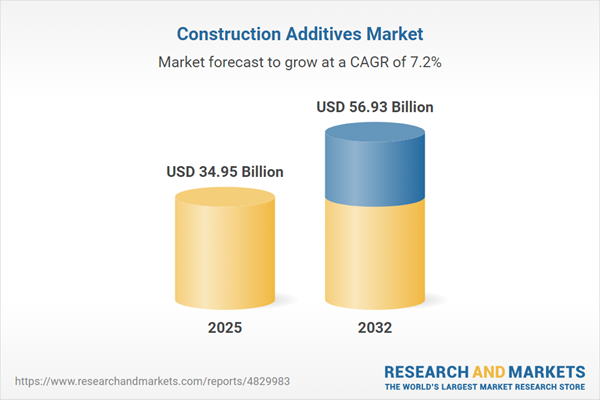Speak directly to the analyst to clarify any post sales queries you may have.
The construction additives market is evolving to address the rising importance of sustainability, complex regulatory environments, and digital innovation. Senior decision-makers must leverage advanced intelligence to manage supply chain risk, optimize procurement, and align portfolio strategies with new standards and technologies.
Market Snapshot: Construction Additives Market Growth and Trends
The construction additives market reached USD 32.73 billion in 2024 and is projected to attain USD 34.95 billion by 2025, supported by a 7.16% compound annual growth rate through 2032. Expansion spans commercial, industrial, infrastructure, and residential sectors, with growth underpinned by investment in sustainable building, growing adoption of digital procurement, and evolving regulations. Suppliers and buyers alike are increasingly focused on optimizing value through advanced additives that enhance procurement, project management, and compliance outcomes. Innovations in materials, process integration, and supply strategies support a more efficient, quality-controlled, and resilient construction sector.
Scope & Segmentation Overview
- Product Types: Accelerators, air-entraining agents, defoamers, hydration control additives, release agents, retarders, superplasticizers, and waterproofing agents. These products address demands for improved durability, application efficiency, and cost management in diverse construction settings.
- Material Types: Natural mineral oil-based, plant-based, synthetic, and hybrid materials. Each offers options to meet sustainability, regulatory, and performance requirements by project or client specification.
- Forms: Aqueous liquid, solvent-based liquid, and powder formats serve conventional methods and modular, prefabricated construction, enabling compatibility with evolving workflows.
- Hazard Classification: Products range from label-free to those requiring detailed hazard identification, supporting tailored safety and compliance strategies for varying operational risks and settings.
- Applications: Asphalt, autoclaved aerated concrete, grouts, plasters, and precast elements. These application areas improve quality control and accelerate critical timelines for new builds and renovations alike.
- End Use: Commercial, industrial, infrastructure, and residential sectors leverage additives for process improvements, better project delivery, and increased lifecycle value.
- Distribution Channels: Direct sales, distributor networks, digital procurement platforms, and e-marketplaces allow for resilient, adaptable supply strategies, ensuring continuity amid market change.
- Regions Covered: Americas, Europe, Middle East & Africa, and Asia-Pacific. Each region faces unique regulatory frameworks, economic conditions, and supplier-buyer relationships influencing procurement and investment.
- Key Players: Clariant AG, BASF SE, Mapei S.p.A., Sika AG, Nouryon Chemicals Holding B.V., The Dow Chemical Company, RPM International Inc., Birla Corporation Limited, Chryso S.A.S. by Saint-Gobain, Pidilite Industries Ltd., Concrete Additives & Chemicals Pvt. Ltd., Denka Company Limited, Mathiesen Group, Tolsa S.A., and Ecoratio. Ongoing innovation and regional expertise drive sector direction and stability.
Key Takeaways for Senior Leaders
- Adoption of construction additives aligns organizations with modern sustainability priorities and prepares teams to comply with evolving global building standards at every project stage.
- Digital integration in procurement and management practices increases transparency, empowering decision-makers to respond rapidly and confidently across complex portfolios.
- Expanding supplier networks and multi-source procurement strategies support resilience, balancing operational needs during unpredictable logistic challenges or regulatory shifts.
- Joint innovation—between suppliers, technology firms, and end users—is accelerating development of bio-based, customized, and self-healing additives that deliver long-term efficiency gains.
- Varied regulatory requirements across continents make local knowledge and tailored risk management essential to maximizing market opportunities while ensuring compliance.
Tariff Impact on Supply Chains
Anticipated changes to US tariffs by 2025 inject further uncertainty into construction admixture supply chains. Senior decision teams are countering volatility by extending supplier networks, prioritizing local sourcing, and boosting inventory flexibility. Enhanced data analytics and adaptive manufacturing capabilities now play a critical role in maintaining project deliverability amid external shocks and policy changes.
Methodology & Data Sources
This market intelligence draws on independent research, expert interviews, technical documentation, and regulatory literature. Multiple source triangulation ensures accuracy and depth for procurement and leadership decisions in the construction additives market.
Why This Report Matters
- Supports strategic planning and digital transformation by mapping key construction additives market trends, enabling organizations to identify and capture growth opportunities.
- Provides segmentation and supplier intelligence for more resilient sourcing and improved risk management as industry complexity increases.
- Equips executive teams with actionable, current insights for adapting to regulatory and operational changes.
Conclusion
Construction additives enable organizations to achieve sustainable, compliant, and efficient project outcomes. High-value market analysis equips leadership with the clarity needed to optimize resources as sector dynamics shift.
Additional Product Information:
- Purchase of this report includes 1 year online access with quarterly updates.
- This report can be updated on request. Please contact our Customer Experience team using the Ask a Question widget on our website.
Table of Contents
3. Executive Summary
4. Market Overview
7. Cumulative Impact of Artificial Intelligence 2025
Companies Mentioned
The companies profiled in this Construction Additives market report include:- Clariant AG
- BASF SE
- Birla Corporation Limited
- Chryso S.A.S. by Saint-Gobain
- ADO Additives Mfg Pvt. Ltd.
- Concrete Additives & Chemicals Pvt. Ltd.
- Denka Company Limited
- Emsland Group
- Fosroc International Ltd.
- Hycrete, Inc.
- Innovation Concrete Laboratory Kft.
- LEVACO Chemicals GmbH
- Mapei S.p.A.
- Mathiesen Group
- Nouryon Chemicals Holding B.V.
- Pidilite Industries Ltd.
- RPM International Inc.
- Sika AG
- Solvay S.A.
- Synthomer PLC
- The Dow Chemical Company
- Thermax Limited
- Tolsa S.A.
- USG Corporation by Knauf Group
- W. R. Grace & Company by Standard Industries
- Ecoratio
Table Information
| Report Attribute | Details |
|---|---|
| No. of Pages | 188 |
| Published | November 2025 |
| Forecast Period | 2025 - 2032 |
| Estimated Market Value ( USD | $ 34.95 Billion |
| Forecasted Market Value ( USD | $ 56.93 Billion |
| Compound Annual Growth Rate | 7.1% |
| Regions Covered | Global |
| No. of Companies Mentioned | 27 |









